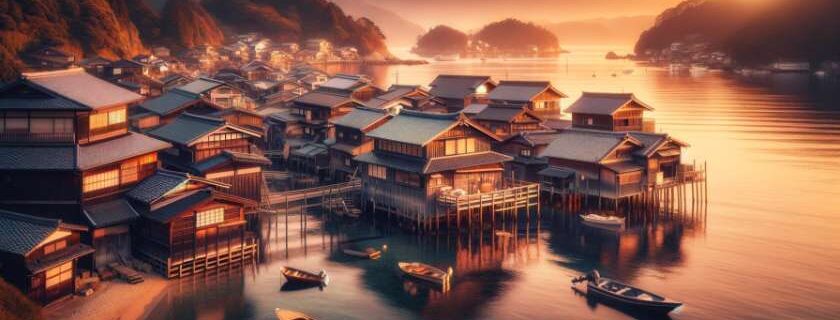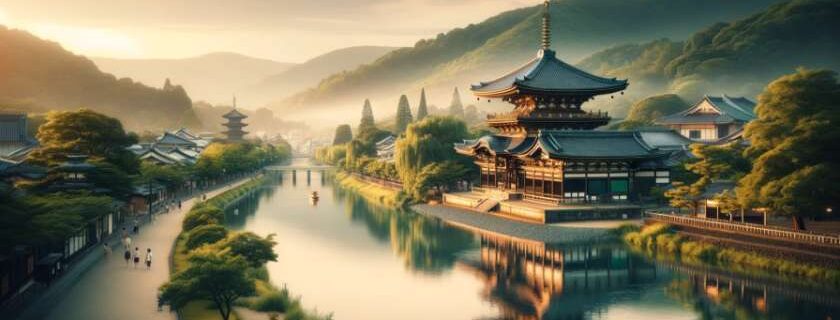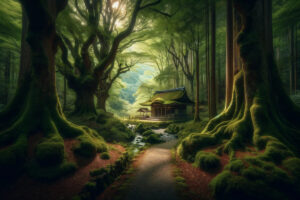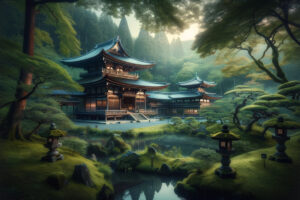
Discover secret spots that promise adventure and awe. From secluded beaches to hidden mountain villages, these off-the-beaten-path locations offer a unique escape from the ordinary. Get ready to explore untouched landscapes, immerse yourself in local culture, and create unforgettable memories off the tourist trail.
Dive into our list to unlock travel treasures waiting to be explored! Scroll down for reviews of our top picks.
- Key Takeaways
- 5 Off-The-Beaten-Path Locations In Kyoto
- 1. Ine: A Charming Seaside Village With Traditional Boathouses
- 2. Miyama: Known For Its Picturesque Thatched-Roof Farmhouses And Rural Landscapes
- 3. Uji: Home To Historic Temples Like Byodoin And Scenic Views Along The Uji River
- 4. Ohara: A Secluded Town With Attractions Such As Sanzen-in Temple And The Beautiful Rurikoin Gardens
- 5. Kurama: A Mountainous Area Offering Hiking Trails, The Scenic Kurama-dera Temple, And A Peaceful Onsen Experience At Kurama Onsen
- Summary
- Frequently Asked Questions
- Is Ine A Suitable Destination For Travelers Seeking Traditional Coastal Experiences?
- What Makes Miyama Stand Out Among Other Destinations Known For Its Rural Landscapes?
- Why Should Tourists Consider Visiting Uji When Exploring Off-The-Beaten-Path Locations In Japan?
- What Sets Ohara Apart As A Secluded Town Worth Exploring?
- How Does Kurama Cater To Adventure Enthusiasts Looking To Explore Mountainous Regions?
Key Takeaways
- Explore off-the-beaten-path locations like Ine, Miyama, Uji, Ohara, and Kurama for unique travel experiences.
- Immerse yourself in the charm of traditional boathouses[1] in Ine and picturesque thatched-roof farmhouses in Miyama.
- Discover the historical richness of Uji with temples like Byodoin and scenic views along the Uji River.
- Experience the tranquility of Ohara’s secluded town, featuring attractions such as Sanzen-in Temple and Rurikoin gardens.
- Embrace nature in Kurama through mountain hikes, visits to Kurama-dera Temple, and a relaxing onsen experience at Kurama Onsen.
- Step off the typical tourist path and uncover hidden gems in these lesser-known destinations.
5 Off-The-Beaten-Path Locations In Kyoto

1. Ine: A Charming Seaside Village With Traditional Boathouses
Ine, a captivating village in Japan, boasts a collection of unique traditional boathouses known as “funaya.” These picturesque structures sit right on the water’s edge, offering visitors an authentic glimpse into the local fishing culture. The charm of Ine lies not only in its stunning views of the sea but also in the preserved essence of a bygone era.
The quaintness and beauty of Ine make it a perfect escape from bustling cities, allowing travelers to immerse themselves in serene surroundings and experience life at a slower pace. Strolling through this small neighborhood feels like stepping back in time, where simplicity and tranquility reign supreme.
One cannot miss indulging in fresh seafood delights while exploring Ine. The village’s proximity to the sea ensures that visitors can savor some of the freshest catches available, adding another layer to their cultural experience.
How To Get There From Kyoto Station:
- By Bus:
- From Kyoto Station, take the Kyoto Tango Miyatoya Railway Line to Amanohashidate Station.
- At Amanohashidate Station, transfer to the Tankai Bus bound for Ine (approximately 60 minutes).
- By Car:
- Drive north from Kyoto Station for about 45 minutes on National Route 178.
- Alternatively, take the Kyoto-Jukan Expressway and exit at Yosa Amanohashidate IC. Then follow National Route 176-178 to reach Ine.
How To Best Experience Ine:
- Amanohashidate: Begin your journey by visiting Amanohashidate, one of Japan’s three most scenic spots. This natural sandbar, beloved for centuries, provides impressive and calming views. Whether you stroll or bike along it, the beauty of Amanohashidate will leave you in awe.
- Ine’s Funaya Boathouses: The heart of Ine lies in its iconic funaya—wooden boathouses. These unique structures have fascinating architecture: the bottom floor stores boats and fishing gear, while the second floor serves as living quarters. The houses appear to float on the bay, creating a magical entrance. Designated as a Group of Historic Buildings, Ine’s funaya offer a glimpse into Edo-period fishermen’s lives. You can explore them through various tours, such as the Ine Bay Cruise, which lets you see the boathouses from the water, or guided tours that take you inside these historic structures.
- Nii Terraced Rice Paddies: Witness the harmonious blend of agriculture and the sea at the Nii Terraced Rice Paddies. These picturesque fields showcase the ingenuity of local farmers as they cultivate rice in a stunning coastal setting.
- Nariaiji Temple: Visit the historic Nariaiji Temple, perched overlooking the bay. Its serene atmosphere and panoramic views make it a peaceful spot for reflection.
- Fukuchiyama Castle: Explore Fukuchiyama Castle, a landmark built by the powerful Akechi Mitsuhide. The castle’s history and architecture are captivating.
- Experiences by the Kyoto Coast:
- Scenic Ride on Kyoto Tango Railways: Let the train take your breath away as you journey along the coast.
- Sip Tea and Stroll through the Tango Region’s Silk and Kimono Tradition: Immerse yourself in the local culture.
- Sample Kyoto’s Rich Sake History at Kumano Brewery: Discover the art of sake-making.
- Go Fishing in Ine like a Local: Experience the village’s maritime heritage.
- Savor Local Flavors with Seko Crab Rice Bowl-Making: Delight in fresh seafood.
- Fry Up Fresh Seasonal Tempura: Enjoy the sea breeze and culinary delights of Kyoto by the sea.
Which Season Is The Best To Visit Ine:
- Spring (March to May):
- Cherry blossoms bloom, creating a magical atmosphere.
- Pleasant weather for exploring the village and its surroundings.
- Ideal for photography, capturing the boathouses against a backdrop of pink blossoms.
- Summer (June to August):
- Warm and humid weather.
- Vibrant green landscapes.
- Enjoy the coastal views and sea breeze.
- Consider taking a boat tour to see the funaya boathouses from the water.
- Autumn (September to November):
- Fall foliage transforms the landscape into a tapestry of red, orange, and gold.
- Cooler temperatures.
- Perfect for hiking or walking along Amanohashidate.
- Winter (December to February):
- Snow-capped mountains create a picturesque scene.
- Quieter and less crowded.
- Experience the cozy charm of the traditional boathouses against a wintry backdrop.
2. Miyama: Known For Its Picturesque Thatched-Roof Farmhouses And Rural Landscapes
Miyama, a gem in northern Kyoto, boasts stunning thatched-roof farmhouses that showcase traditional Japanese architecture. These unique structures immerse visitors in the charm of the countryside.
The tranquil escape Miyama offers is unparalleled; surrounded by breathtaking landscapes, it’s a perfect retreat from the hustle and bustle of city life. Walking through this underrated destination feels like stepping back in time to experience authentic Japanese culture.
In Miyama, you can witness firsthand the artistry of traditional crafts such as machiya houses and tea houses. The moss-covered gardens and cherry blossoms add an extra layer of beauty to this serene setting.
For those seeking a peaceful retreat or interested in exploring lesser-known parts of Japan, Miyama stands out as an ideal destination. Its pavilions and gardens offer a glimpse into historical Japan while providing a sense of tranquility rarely found in more popular tourist spots.
How To Get There From Kyoto Station:
- Train and Bus (Recommended Option):
- Take a train from Kyoto Station Karasumaguchi to Miyama (Station) via Fukui (Fukui). This journey takes approximately 3 hours and 1 minute.
- Alternatively, you can take a bus operated by Keifuku Bus from Fukakusa to Fukui (twice daily). The bus ride lasts about 2 hours and 35 minutes.
- Train and Bus via Sonobe:
- Take the train from Kyoto to Sonobe (JR Sagano Line).
- Then, transfer to a bus from Hiyoshi (Kyoto) to Miyama Kayabuki-no-Sato.
- This route takes approximately 2 hours and 51 minutes.
- Taxi:
- You can also take a taxi directly from Kyoto Station to Miyama. The distance is approximately 56.6 kilometers, and the taxi ride typically takes around 51 minutes. Expect a fare of ¥20,000 to ¥24,000.
- Self-Drive:
- If you prefer driving, you can take your car from Kyoto Station to Miyama. The drive covers approximately 56.6 kilometers and usually takes about 51 minutes. Estimated toll fees range from ¥850 to ¥1,300.
How To Best Experience Miyama:
- Explore the Thatched-Roof Farmhouses (“Kayabuki”):
- Wander through the village and admire the traditional thatched-roof houses. These kayabuki structures are architectural gems, each with a unique design. Take your time to appreciate the craftsmanship and historical significance of these charming dwellings.
- Stroll Amidst Breathtaking Landscapes:
- Miyama is surrounded by serene countryside vistas. Take leisurely walks along the narrow lanes, breathe in the fresh air, and let the tranquility of the rural setting wash over you. The lush greenery, rolling hills, and seasonal changes create a soothing atmosphere.
- Visit Kayabuki no Sato (Thatched-Roof Village):
- Explore Kayabuki no Sato, a preserved area where many of the thatched-roof houses are clustered. This open-air museum allows you to step back in time and experience life as it was in rural Japan. Learn about the history, architecture, and daily routines of the villagers.
- Admire Moss-Covered Gardens:
- Some of the kayabuki houses have beautiful moss-covered gardens. These serene patches of green add to the overall charm of Miyama. Take a moment to appreciate the delicate balance between nature and human habitation.
- Cherry Blossom Viewing (Spring):
- If you visit in spring (March to May), witness the magic of cherry blossoms. The pink blossoms against the thatched roofs create a dreamy scene. Capture the beauty with your camera or simply enjoy the fleeting moments.
- Experience Tea Culture:
- Miyama offers opportunities to participate in traditional tea ceremonies. Visit a chashitsu (tea house) and savor matcha while surrounded by the rustic beauty of the countryside.
- Stay in a Thatched-Roof Guesthouse:
- Extend your stay by booking a night in one of the converted kayabuki guesthouses. Imagine sleeping under the same thatched roof that generations of villagers once called home. It’s a unique and memorable experience.
- Photography and Sketching:
- Miyama’s landscapes are a haven for photographers and artists. Capture the changing light, shadows, and textures. Whether you’re a professional or an amateur, the scenery will inspire you.
- Local Cuisine:
- Sample regional dishes made from fresh, locally sourced ingredients. Try soba noodles, wild vegetables, and other specialties. The flavors reflect the simplicity and authenticity of Miyama.
- Attend Seasonal Festivals:
- Check if any local festivals or events coincide with your visit. Participating in traditional celebrations allows you to connect with the community and learn more about Miyama’s cultural heritage.
Which Season Is The Best To Visit Miyama:
- Spring (March to May):
- Cherry blossoms adorn the landscape, creating a magical atmosphere.
- Pleasant weather for exploring the village and its surroundings.
- Ideal for photography, capturing the thatched-roof houses against a backdrop of pink blossoms.
- Summer (June to August):
- Warm and humid weather.
- Vibrant green landscapes.
- Enjoy the coastal views and sea breeze.
- Consider taking a boat tour to see the funaya boathouses from the water.
- Autumn (September to November):
- Fall foliage transforms the landscape into a tapestry of red, orange, and gold.
- Cooler temperatures.
- Perfect for hiking or walking along Amanohashidate.
- Winter (December to February):
- Snow-capped mountains create a picturesque scene.
- Quieter and less crowded.
- Experience the cozy charm of the traditional boathouses against a wintry backdrop.

3. Uji: Home To Historic Temples Like Byodoin And Scenic Views Along The Uji River
Uji, a city steeped in history, boasts renowned ancient temples such as the iconic Byodoin Temple. The Byodoin Temple is a UNESCO World Heritage Site known for its architectural beauty and cultural significance.
Flowing through Uji is the picturesque Uji River, providing visitors with stunning vistas and tranquil walking paths to unwind amidst nature’s splendor. Walking along the riverbank offers a serene escape from bustling city life.
Exploring Uji allows travelers to immerse themselves in Japanese heritage by visiting various temples while also enjoying the calming presence of the flowing river. It’s an ideal destination for those seeking both cultural enrichment and natural beauty on their day trips or travels.
How To Get There From Kyoto Station:
- JR Train (Recommended Option):
- Take a JR Nara Line train from Kyoto Station to JR Uji Station directly. All trains on the JR Nara Line stop at JR Uji Station.
- If you catch a Rapid service, you can reach JR Uji Station in just 19 minutes. Alternatively, a Local train stops at all stations along the way, taking no more than 30 minutes.
- The fare for this journey is only 240 yen.
- Use the JR West Timetable & Route Finder to find the best train for your trip.
- Keihan Train:
- If you prefer the Keihan Main Line, which runs north to south through central Kyoto:
- From central Kyoto, use Sanjo Station or Gion Shijo Station to access the Keihan Main Line.
- If you’re traveling from Kyoto Station, take a JR Nara Line train to Tofukuji Station and transfer to the Keihan Main Line there.
- From Tofukuji Station, take the Keihan Main Line to Chushojima Station, and then transfer to the Keihan Uji Line.
- The Keihan Uji Line has only 8 stops, so it takes about 15 minutes to reach the end of the line.
- The fare from Keihan Tofukuji Station to Keihan Uji Station is 310 yen, and the journey lasts approximately 37 minutes.
- For the best trains and connections, use the online English route finder Hyperdia.
- If you prefer the Keihan Main Line, which runs north to south through central Kyoto:
- Taxi or Self-Drive:
- Alternatively, you can take a taxi directly from Kyoto Station to Uji (approximately 20 minutes).
- If you prefer driving, the distance is about 56.6 kilometers, and it usually takes around 51 minutes. Estimated toll fees range from ¥850 to ¥1,300.
How To Best Experience Uji:
- Explore Byodoin Temple:
- Begin your journey by visiting the iconic Byodoin Temple. Marvel at the graceful architecture of the Phoenix Hall (Hoodo), which reflects in the surrounding pond. This UNESCO World Heritage Site is a symbol of Uji’s rich history and cultural significance.
- Stroll Along the Uji River:
- The picturesque Uji River offers tranquil walking paths. Take leisurely walks along the riverbanks, surrounded by cherry trees. Let the soothing flow of the river wash away the hustle and bustle of urban life.
- Visit Ujigami Shrine:
- Ujigami Shrine, another UNESCO World Heritage Site, is one of Japan’s oldest Shinto shrines. Its serene atmosphere and ancient architecture make it a must-see.
- Try Uji Matcha Green Tea:
- Uji is renowned for its high-quality matcha (green tea). Visit a traditional tea house and savor a cup of Uji matcha. The rich flavor and vibrant green color are a treat for the senses.
- Explore Uji City Museum:
- Learn about Uji’s history and heritage at the Uji City Museum. Discover artifacts, artworks, and exhibits that showcase the city’s past.
- Uji Bridge (Ujibashi):
- Cross the historic Uji Bridge, which spans the Uji River. The view from the bridge is especially beautiful during cherry blossom season.
- Seasonal Festivals:
- Check if any local festivals or events are happening during your visit. Participating in traditional celebrations allows you to connect with the community and experience Uji’s vibrant culture.
- Uji Tea Fields:
- Take a short trip to the nearby Uji tea fields. The rolling hills covered in tea bushes create a serene and picturesque landscape.
- Uji Plum Blossoms (February to March):
- If you visit in late winter to early spring, enjoy the blooming plum blossoms. Uji is famous for its plum orchards, and the fragrance and colors are delightful.
- Relax at Uji Park:
- Uji Park, located near Byodoin Temple, offers a peaceful setting for relaxation. Enjoy a picnic, read a book, or simply take in a natural beauty.
Which Season Is The Best To Visit Uji:
- Spring (March to May):
- Byodoin Temple is especially enchanting during spring. The temple’s Pure Land Garden comes alive with cherry blossoms, creating a serene and ethereal atmosphere. Stroll through the temple grounds, admire the iconic Phoenix Hall, and enjoy the delicate pink hues of sakura petals.
- The Uji River banks are also adorned with cherry blossoms, making it a perfect time for a leisurely riverside walk or a boat cruise. The views are simply breathtaking.
- Autumn (September to November):
- The fall foliage complements the beautiful architecture of Byodoin Temple. The temple, built in the nagare-zukuri style, features an asymmetrical gabled roof that extends outward to protect worshippers. The vibrant reds, oranges, and yellows of the leaves create a stunning contrast against the temple’s serene backdrop.
- If you’re visiting around late November, consider exploring Koshoji Temple, where maple trees line the main approach. The temple grounds feature a striking five-storied pagoda, perfect for autumn leaf viewing.
- Summer (June to August):
- Uji River offers unique experiences during summer. Tourists can enjoy river cruises and even witness cormorant fishing around dusk. The same boats are used for both daytime cruises and the traditional fishing practice. Cormorant fishing takes place from mid-June to late September, adding a touch of cultural intrigue to your visit.
4. Ohara: A Secluded Town With Attractions Such As Sanzen-in Temple And The Beautiful Rurikoin Gardens
Ohara, a hidden gem, offers a tranquil escape from bustling cities. The serene atmosphere of Sanzen-in Temple is a major draw for visitors seeking peace and beauty.
The Rurikoin gardens in Ohara are renowned for their vibrant autumn foliage, making it an ideal spot for nature lovers and photographers alike. This hidden gem provides a unique experience away from the typical tourist destinations.
Visitors to Ohara can immerse themselves in the lush greenery and picturesque surroundings that epitomize this tranquil haven. The town’s charm lies in its ability to transport you to another world, far removed from the hustle and bustle of urban life.
Hidden gems like Ohara offer travelers a chance to discover lesser-known yet equally captivating destinations that showcase the true essence of serenity amidst nature’s wonders. If you seek solace amid stunning landscapes, then Ohara is an unmissable stop on your travel itinerary.
How To Get There From Kyoto Station:
- By Bus:
- Most tourists visit Ohara by bus. From Kyoto station, follow these steps:
- Exit the bus station on the left side.
- Cross the road at the traffic signal.
- Continue eastward, passing a noodle restaurant on your left.
- Follow the sloping path along the Ro-gawa River.
- Eventually, you’ll reach Raigo-in Temple.
- Raigo-in Temple is known for its unique spiritual music and serene surroundings. Monks still chant Buddhist scriptures here, as they have for over a thousand years. You can even purchase a CD of this ancient music at the temple reception.
- Continue east into the woods, following the river, and you’ll discover the beauty of Ohara.
- Most tourists visit Ohara by bus. From Kyoto station, follow these steps:
- Sanzen-in Temple:
- Address: 540 Ohara Raikoin-cho, Sakyo-ku, Kyoto, 601-1242.
- Hours: Open daily from 9:00 AM to 4:30 PM (varies slightly on different days).
- Highlights:
- The temple’s main hall enshrines three Buddha images.
- The garden, adorned with azalea bushes, is especially beautiful in spring.
- Experience the ancient Buddhist chanting music called “shomyo” which has been practiced here for centuries.
- Don’t miss the belfry and the serene atmosphere of Sanzen-in.
- Rurikoin Temple:
- Location: In the northern suburb of Kyoto (Yase-Ohara).
- Seasonal Views:
- Spring: Fresh greenery and cherry blossoms.
- Autumn: Vibrant autumn leaves.
- Admission Fee: 2,000 yen (as of autumn 2016).
- Worth It: Despite the cost, Rurikoin’s beauty makes it worthwhile. Visitors receive a sutra copying paper, a ball-point pen, and a pamphlet upon admission. You can even try sutra copying in the Shoin (Study Hall).
How To Best Experience Ohara:
- Sanzen-in Temple:
- Address: 540 Ohara Raikoin-cho, Sakyo-ku, Kyoto, 601-1242.
- Hours: Open daily from 9:00 AM to 4:30 PM (varies slightly on different days).
- Highlights:
- Spiritual Music: Sanzen-in Temple is a place where monks still chant ancient Buddhist scriptures using a unique spiritual music called “shomyo.” This tradition has persisted for over a thousand years.
- Azalea Gardens: The temple’s garden, adorned with azalea bushes, is especially beautiful during spring. The vibrant colors create a serene backdrop for contemplation.
- Belfry and Main Hall: Explore the main hall, where three Buddha images are enshrined. The surrounding garden provides a peaceful spot to listen to the wind rustling through the trees.
- Raigo-in Temple:
- Location: Continue eastward along the Ro-gawa River from Sanzen-in.
- History: Originally established in the 9th century, Raigo-in Temple is associated with the unique spiritual music “shomyo.” Monks still chant Buddhist scriptures here every weekend.
- CD of Ancient Music: You can purchase a CD of this ancient music at the temple reception.
- Main Hall and Garden: Visit the main hall, where Buddha images reside. The garden, surrounded by azalea bushes, offers a serene atmosphere for reflection.
- Rurikoin Temple:
- Location: In the northern suburb of Kyoto (Yase-Ohara).
- Seasonal Views:
- Spring: Fresh greenery and cherry blossoms.
- Autumn: Vibrant autumn leaves.
- Admission Fee: 2,000 yen (as of autumn 2016).
- Worth It: Despite the cost, Rurikoin’s beauty makes it worthwhile. Upon admission, you’ll receive a sutra copying paper, a ballpoint pen, and a pamphlet. Try sutra copying in the Shoin (Study Hall).
Which Season Is The Best To Visit Ohara:
- Sanzen-in Temple:
- Autumn: The garden at Sanzen-in Temple is in its glory during autumn. Large crowds gather to witness the vibrant fall colors. The serene atmosphere and the ancient Buddhist chanting music called “shomyo” make it a worthwhile visit. The temple’s main hall enshrines three Buddha images, and the azalea bushes add to the beauty of the surroundings.
- Spring: During spring, the garden also comes alive with fresh greenery and cherry blossoms. The view from the second floor, where desks act as mirrors reflecting the fall leaves outside, is often referred to as the “Fall Foliage of Dreams” and is truly enchanting.
- Rurikoin Gardens:
- Autumn: The Rurikoin gardens are renowned for their vibrant autumn foliage. If you’re a nature lover or a photographer, this is the ideal time to visit. The striking contrast of reds, oranges, and yellows against the temple’s serene backdrop creates a captivating scene.
- Spring: While autumn steals the show, the gardens are equally delightful during spring when cherry blossoms bloom.
5. Kurama: A Mountainous Area Offering Hiking Trails, The Scenic Kurama-dera Temple, And A Peaceful Onsen Experience At Kurama Onsen
Kurama is an ideal destination for nature lovers seeking serene escapes. The region boasts abundant hiking trails that wind through lush mountains, providing an immersive outdoor experience.
Visitors to Kurama can explore the tranquil Kurama-dera Temple, known for its spiritual significance and breathtaking panoramic views of the surrounding landscape. This temple offers not only a place for meditation but also a glimpse into Japan’s rich cultural heritage.
For those in search of relaxation, Kurama Onsen awaits with its traditional hot spring experience nestled amidst the picturesque mountains. Here, guests can unwind and rejuvenate in the healing waters while immersing themselves in the natural beauty of the area.
Whether you are looking to hike along scenic trails, immerse yourself in cultural experiences at temples, or simply unwind in a soothing hot spring setting, Kurama offers a diverse range of experiences that cater to different preferences.
How To Get There from Kyoto Station:
- Subway and Train Option (Recommended):
- Take the Kyoto City Subway Karasuma Line from Kyoto Station to Kokusaikaikan Station.
- Walk to Hachiman-Mae (Kyoto) station.
- From there, board the Eizan Electric Railway to Kurama Station.
- This route takes approximately 1 hour and 5 minutes.
- Taxi Option:
- If you prefer a quicker journey, take a taxi directly from Kyoto Station to Kurama. The distance is about 18.9 kilometers.
- Expect the taxi fare to be around ¥7,000 to ¥8,500.
- Bus and Train Option:
- Catch the Line 205 bus from Kyoto Station to Aoibashi Nishizume.
- Transfer to the Eizan Electric Railway at Demachiyanagi Station and ride it to Kurama.
- This option also takes approximately 1 hour and 6 minutes.
How To Best Experience Kurama:
- Explore the Hiking Trails:
- Begin your adventure by hiking through the lush, forested trails of Kurama. The mountainous terrain offers breathtaking views and a sense of tranquility. Don’t forget to wear comfortable shoes and carry water for the journey.
- Visit Kurama-dera Temple:
- Ascend to the Kurama-dera Temple, perched on the mountainside. This sacred Buddhist temple exudes serenity and history. Marvel at the ancient architecture, intricate carvings, and vibrant red hues. Take a moment to meditate or simply soak in the spiritual atmosphere.
- Relax at Kurama Onsen:
- After your exploration, reward yourself with a soothing onsen experience at Kurama Onsen. Nestled amidst nature, this traditional hot spring offers rejuvenation for both body and soul. Immerse yourself in the warm waters while surrounded by forested hills.
- Enjoy Local Cuisine:
- Savor local delicacies at one of Kurama’s cozy restaurants. Try dishes made with wild mountain vegetables, tofu, and other seasonal ingredients. The flavors are as refreshing as the mountain air.
- Witness the Fire Festival (Yuki Matsuri):
- If you visit in October, don’t miss the Kurama Fire Festival. Witness the mesmerizing procession of torches, chanting monks, and vibrant energy. It’s a unique cultural experience that adds to Kurama’s mystique.
Which Season Is The Best To Visit Kurama:
- Spring (March to May):
- Cherry blossoms grace Kurama during spring, creating a magical atmosphere around Kurama-dera Temple. Stroll through the temple grounds under blooming sakura trees and witness the Spring Full Moon Festival, a serene celebration.
- Summer (June to August):
- While Kyoto can be sweltering, Kurama remains cooler due to its mountainous location. August is particularly pleasant for a visit. Explore the hiking trails surrounded by lush greenery and enjoy the Kurama Onsen’s warm waters without the intense heat of the city.
- Autumn (September to November):
- Fall foliage transforms Kurama’s forests into a vibrant canvas of red and gold. Hike through the colorful trails, visit the temple, and soak in the Kurama Onsen while enveloped in autumn hues.
- Winter (December to February):
- Kurama dons a serene blanket of snow, creating a picturesque landscape. The temple looks ethereal against the white backdrop. Experience the Fall Fire Festival (Yuki Matsuri) in November or admire the snow-covered scenery in December and beyond.

Summary
You’ve now explored some incredible off-the-beaten-path locations in Japan, each offering a unique charm and experience. From the seaside village of Ine with its traditional boathouses to the rural landscapes of Miyama and the historic temples of Uji, there’s no shortage of hidden gems to discover. Ohara’s secluded town and Kurama’s mountainous terrain provide a perfect blend of tranquility and adventure.
Why not step off the well-trodden tourist path and venture into these lesser-known areas? Embrace the opportunity to immerse yourself in Japan’s rich culture, surrounded by stunning natural beauty. Pack your bags, grab your camera, and get ready for an unforgettable journey through these enchanting off-the-beaten-path destinations in the Land of the Rising Sun.
Frequently Asked Questions
Is Ine A Suitable Destination For Travelers Seeking Traditional Coastal Experiences?
Ine is perfect for those craving authentic seaside vibes with its charming boathouses and serene atmosphere. You can immerse yourself in the local culture, witness traditional fishing practices, and enjoy picturesque views of the sea.
What Makes Miyama Stand Out Among Other Destinations Known For Its Rural Landscapes?
Miyama’s appeal lies in its stunning thatched-roof farmhouses set against beautiful countryside backdrops. It offers a glimpse into Japan’s rustic charm, providing visitors with a peaceful retreat from urban life amidst nature’s tranquility.
Why Should Tourists Consider Visiting Uji When Exploring Off-The-Beaten-Path Locations In Japan?
Uji boasts a rich historical heritage showcased through iconic temples like Byodoin and scenic spots along the Uji River. This hidden gem offers a blend of cultural immersion and natural beauty, making it an ideal escape for travelers seeking unique experiences.
What Sets Ohara Apart As A Secluded Town Worth Exploring?
Ohara captivates visitors with its tranquil ambiance, featuring attractions like Sanzen-in Temple and Rurikoin gardens that exude serenity and beauty. It provides an oasis away from bustling tourist hotspots, allowing you to unwind amidst lush greenery and spiritual sanctuaries.
How Does Kurama Cater To Adventure Enthusiasts Looking To Explore Mountainous Regions?
Kurama beckons thrill-seekers with its diverse offerings such as hiking trails, Kurama-dera Temple visits offering panoramic views, and rejuvenating onsen experiences at Kurama Onsen. The area presents opportunities for exploration while embracing nature’s wonders in a setting conducive to both adventure and relaxation.




